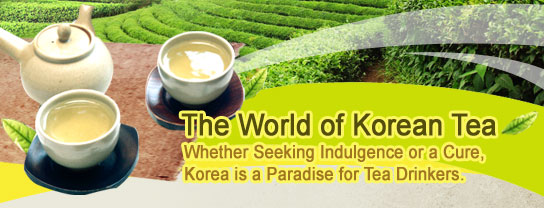 | |||||
Along with coffee and cocoa, tea has been the drink of
choice throughout the world since the beginning of time. Throughout history
people have shared a spot of tea and stories with close friends, relaxed with a
hot cup before bed, or kick-started their day with a freshly-brewed pot. Tea has
even become an integral part of official occasions, serving as an international
symbol of welcome for foreign officials and guests.
Tea is among the world’s three major indulgence beverages, along with coffee and cocoa. It is esteemed for its organic qualities, in the West as well as in the East, and was used largely for cultural rites and medicinal purposes before gaining popularity internationally as a daily beverage. | |||||
| |||||
| |||||
With a history dating back over 2,000 years, Korean
traditional teas have long since played a prominent part in the nation’s
culture. Along with the spread of Buddhism from China (ancient Yue) in the late
Three Kingdoms period (about 1,100 years ago), came the introduction of the
Chinese indigenous tea plant Camellia sinensis, from which white, green, oolong,
pu-erh, and black teas are made. As tea gained popularity throughout the nation,
a variety of different teas were created, leading to the development of a unique
tea culture that is specific to Korea. When the Joseon Dynasty (late 14th
century) began, Confucianism overtook Buddhism, and in time, tea consumption
declined, replaced by beverages like sikhye and sujeonggwa. It wasn’t until
years later in the 1960s-1980s that tea started to reclaim its title as one of
the nation’s favorite beverages and became more readily available. Keep reading
to learn more about some of Korea’s most beloved teas.
| |||||
| |||||
There are four types of traditional teas in Korea:
green tea, medicinal herb tea, fruit-based tea, and grain-based tea.
Saenggangcha (생강차, ginger tea), insamcha (인삼차, ginseng tea), and ssanghwacha
(쌍화차, medicinal tea) are teas made of medicinal herbs or other traditional
ingredients. Fruit-based teas include daechucha (대추차, jujube tea), yujacha (유자차,
citron tea), omijacha (오미자차, Schizandra tea), mogwacha (모과차, Chinese quince
tea), and maesilcha (매실차, plum tea). Grain-based teas include yulmucha (율무차,
adlay tea) and boricha (보리차, barley tea). Teas from dried flowers or leaves can
be made by boiling the flowers or leaves for 3 to 5 minutes. Teas from fruits,
roots, or bark are brewed for 10 to 30 minutes, depending on whether the
ingredients are whole or in powdered form. If the tea includes hard seeds or a
mixture of various herbs, the boiling time will be longer. Tea is best prepared
using soft water with a low mineral content and containers made of glass or
ceramic, not metal.
|
Following its miraculous development over the last 50 years, Korea is now a modernized vibrant nation that still maintains its traditional culture. Learn all about this fascinating country.
Ranking 1 Blue-bigbang
2. 2AM / I Wonder If You Hurt Like Me
2012년 2월 17일 금요일
Traditional Teas
피드 구독하기:
댓글 (Atom)
3.BigBang / FANTASTIC BABY
4.miss A / Touch
5.T-ara / Lovey-Dovey
6.FTISLAND / Fiercely
7~ 10
7.Ailee / Heaven
8.John Park / Falling
9.K.WILL / I Need You
10,Trouble Maker / Trouble Maker
댓글 없음:
댓글 쓰기